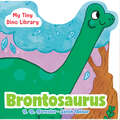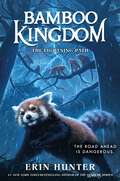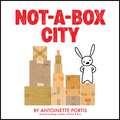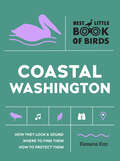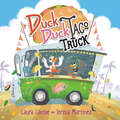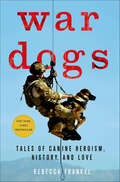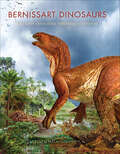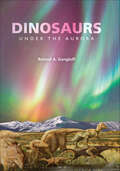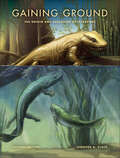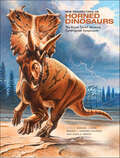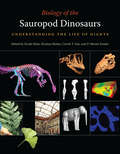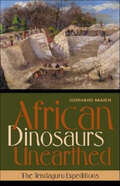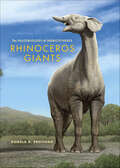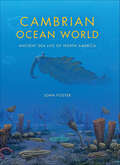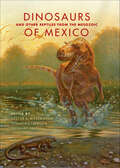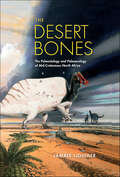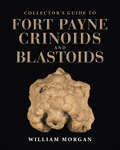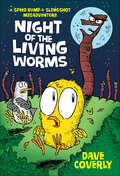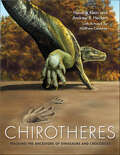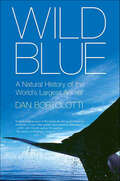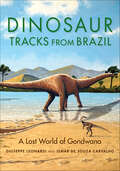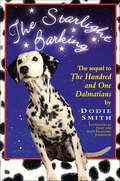- Table View
- List View
Brontosaurus (My Tiny Dino Library)
by J. D. ForesterYoung readers will love exploring this dinosaur-shaped board book filled with playful rhymes and facts all about the mighty Brontosaurus!Stomp, stomp, stomp! Roar, roar, roar! Learn all about Brontosaurus, the &“thunder lizard&” dinosaur!
Bamboo Kingdom #5: The Lightning Path (Bamboo Kingdom #5)
by Erin HunterExplore the secrets of the Bamboo Kingdom in the fifth installment of this thrilling new series from bestselling Warriors author Erin Hunter, perfect for fans of the Wings of Fire and Endling series.The three Dragon Speakers must face their own troubles before they can help the Bamboo Kingdom regain peace.After being forced out of Rain’s camp for a murder he did not commit, Ghost is still determined to prove his innocence. And though Rain isn’t convinced Ghost is guilty, she knows that if it wasn’t him, that means the killer is still at large—and still targeting her loved ones.As Ghost sets out to reunite both of his families, Leaf is nowhere to be found, and the monkeys are watching their every move. With only piecemeal guidance from a Great Dragon that’s been split in three, how can they hope to stop what Brawnshanks is planning?
Familiaris: ‘Wroblewski has set a story-telling bonfire as enthralling in its pages as it is illuminating of our fragile and complicated humanity’ Tom Hanks
by David Wroblewski'A story-telling bonfire as enthralling in its pages as it is illuminating of our fragile and complicated humanity. Familiaris is as expansive and enlightening a saga as has ever been written' Tom Hanks'Impossibly wise, impossibly ambitious, impossibly beautiful' Richard Russo'An American tour de force' Colum McCannSpring 1919, and John Sawtelle's imagination has got him into trouble...again. Now John and his newlywed wife, Mary, along with their two best friends and their three dogs, are setting off for Wisconsin's north woods, where they hope to make a fresh start - and to live a life of meaning, purpose, and adventure. But the place they are headed for is far stranger and more perilous than they realize, and it will take all their ingenuity, along with a few new friends - human, animal, and otherworldly - to realise their dreams.By turns hilarious and heartbreaking, mysterious and enchanting, Familiaris takes readers on an unforgettable journey from the halls of a small-town automobile factory, through an epic midwestern firestorm and an ambitious WWII dog training program, examining the dynamics of love and friendship, the vexing nature of families, the universal desire to create something lasting and beautiful, and of course, the species-long partnership between Homo sapiens and Canis familiaris.
Not-a-Box City
by Antoinette PortisDon't miss the long-awaited companion to Not a Box, winner of a Theodor Seuss Geisel Honor Award. This picture book with its visual humor and simple dialogue is great for fans of Mo Willems and Crockett Johnson.Bunny wants to build a cardboard city.Bunny stacks one cardboard box on top of another and another.Bunny doesn't want any help. Bunny doesn't need any help, either.But what's a cardboard city without friends?Written and illustrated with the same delightful simplicity that made Not a Box such a hit, the playtime possibilities of a stack of boxes and friendship will inspire and excite any child who has ever journeyed into the world of make-believe.
Baby Loves Paleontology (Baby Loves Science)
by Ruth SpiroThe Baby Loves Science board book series is big, brainy science for the littlest listeners.Baby loves to dig! Maybe she'll discover something deep underground--like a fossil. Accurate enough to satisfy an expert, yet simple enough for baby, this clever board book explores fossils, dinosaurs, and the field of paleontology.Beautiful, visually stimulating illustrations complement age-appropriate language to encourage baby's sense of wonder. Parents and caregivers may learn a thing or two as well!
Best Little Book of Birds Coastal Washington
by Tamara EnzThis practical, pocket-sized book is a beginner-friendly guide to the amazing birds you can find in the coastal areas of the Evergreen State. Washington&’s coast is teeming with scores of beautiful birds, and the Best Little Book of Birds: Coastal Washington will help you find them. This easy-to-use book will help you identify more than 100 commonly occurring birds that help make the Washington coast the natural wonder that it is. An emphasis on best practices and habitat sustainability help empower conservation and ensure that birding on the coast will be possible for years to come. Perfect for budding and experienced birders alike, this sleek and compact guide is the ideal travel companion for every trip to the coast.
Duck Duck Taco Truck
by Laura LavoieIt's a summer showdown at the beach as two taco slinging ducks see their turf taken over by an enterprising goose. This rollicking, rhyming, beachy read-aloud is sure to bring on lots of giggles."Duck. Duck. Taco truck. Working hard to make a buck."Two food trucks staffed by sworn enemies: ducks vs. geese. Before you can say "curly fries", these two rivals are in an epic food truck face-off. "Battle on! At dawn, we ride!"But soon, Goose becomes overwhelmed by hangry crowds. He sure could use some extra wings to help out! Will these foes find a solution and become feathered friends?This clever, high-energy, taco tale, packed with bright art featuring kids' favorite foods, shows young readers how cooperation and teamwork can overcome conflict. It's a superbly silly summer story, the perfect pick for taco and truck fans.
Familiaris
by David WroblewskiA stirring, unputdownable masterpiece—and the follow-up to the beloved #1 New York Times bestselling modern classic The Story of Edgar Sawtelle.It is spring 1919, and John Sawtelle's imagination has gotten him into trouble . . . again. Now John and his newlywed wife, Mary, along with their two best friends and their three dogs, are setting off for Wisconsin's north woods, where they hope to make a fresh start—and, with a little luck, discover what it takes to live a life of meaning, purpose and adventure. But the place they are headed for is far stranger and more perilous than they realize, and it will take all their ingenuity, along with a few new friends—human, animal and otherworldly—to realize their dreams.By turns hilarious and heartbreaking, mysterious and enchanting, Familiaris takes readers on an unforgettable journey from the halls of a small-town automobile factory, through an epic Midwestern firestorm and an ambitious WWII dog training program, and far back into mankind's ancient past, examining the dynamics of love and friendship, the vexing nature of families, the universal desire to create something lasting and beautiful, and of course, the species-long partnership between homo sapiens and canis familiaris.
War Dogs: Tales of Canine Heroism, History, and Love
by Rebecca Frankel*A New York Times bestseller* A compelling look at the important role that dogs have played in America's most recent military conflicts, replete with the touching stories of individual dogs and their handlers/soldiersUnder the cover of night, deep in the desert of Afghanistan, a US Army handler led a Special Forces patrol with his military working dog. Without warning an insurgent popped up, his weapon raised. At the handler's command, the dog charged their attacker. There was the flash of steel, the blur of fur, and the sound of a single shot; the handler watched his dog take a bullet. During the weeks it would take the dog to heal, the handler never left its side. The dog had saved his life. Loyal and courageous, dogs are truly man's best friend on the battlefield. While the soldiers may not always feel comfortable calling the bond they form love, the emotions involved are strong and complicated. In War Dogs, Rebecca Frankel offers a riveting mix of on-the-ground reporting, her own hands-on experiences in the military working dog world, and a look at the science of dogs' special abilities--from their amazing noses and powerful jaws to their enormous sensitivity to the emotions of their human companions. The history of dogs in the US military is long and rich, from the spirit-lifting mascots of the Civil War to the dogs still leading patrols hunting for IEDs today. Frankel not only interviewed handlers who deployed with dogs in wars from Vietnam to Iraq, but top military commanders, K-9 program managers, combat-trained therapists who brought dogs into war zones as part of a preemptive measure to stave off PTSD, and veterinary technicians stationed in Bagram. She makes a passionate case for maintaining a robust war-dog force. In a post-9/11 world rife with terrorist threats, nothing is more effective than a bomb-sniffing dog and his handler. With a compelling cast of humans and animals, this moving book is a must read for all dog lovers--military and otherwise.
Bernissart Dinosaurs and Early Cretaceous Terrestrial Ecosystems (Life of the Past)
by Pascal GodefroitIn 1878, the first complete dinosaur skeleton was discovered in a coal mine in Bernissart, Belgium. Iguanodon, first described by Gideon Mantell on the basis of fragments discovered in England in 1824, was initially reconstructed as an iguana-like reptile or a heavily built, horned quadruped. However, the Bernissart skeleton changed all that. The animal was displayed in an upright posture similar to a kangaroo, and later with its tail off the ground like the dinosaur we know of today. Focusing on the Bernissant discoveries, this book presents the latest research on Iguanodon and other denizens of the Cretaceous ecosystems of Europe, Asia, and Africa. Pascal Godefroit and contributors consider the Bernissart locality itself and the new research programs that are underway there. The book also presents a systematic revision of Iguanodon; new material from Spain, Romania, China, and Kazakhstan; studies of other Early Cretaceous terrestrial ecosystems; and examinations of Cretaceous vertebrate faunas.
Dinosaurs Under the Aurora (Life of the Past)
by Roland A. GangloffIn 1961, while mapping rock exposures along the Colville River in Alaska, an oil company geologist would unknowingly find the evidence for a startling discovery. Long before the North Slope of Alaska was being exploited for its petroleum resources it was a place where dinosaurs roamed. Dinosaurs under the Aurora immerses readers in the challenges, stark beauty, and hard-earned rewards of conducting paleontological field work in the Arctic. Roland A. Gangloff recounts the significant discoveries of field and museum research on Arctic dinosaurs, most notably of the last 25 years when the remarkable record of dinosaurs from Alaska was compiled. This research has changed the way we think about dinosaurs and their world. Examining long-standing controversies, such as the end-Cretaceous extinction of dinosaurs and whether dinosaurs were residents or just seasonal visitors to polar latitudes, Gangloff takes readers on a delightful and instructive journey into the world of paleontology as it is conducted in the land under the aurora.
Gaining Ground: The Origin and Evolution of Tetrapods (Life of the Past)
by Jennifer A. ClackAround 370 million years ago, a distant relative of a modern lungfish began a most extraordinary adventure—emerging from the water and laying claim to the land. Over the next 70 million years, this tentative beachhead had developed into a worldwide colonization by ever-increasing varieties of four-limbed creatures known as tetrapods, the ancestors of all vertebrate life on land. This new edition of Jennifer A. Clack's groundbreaking book tells the complex story of their emergence and evolution. Beginning with their closest relatives, the lobe-fin fishes such as lungfishes and coelacanths, Clack defines what a tetrapod is, describes their anatomy, and explains how they are related to other vertebrates. She looks at the Devonian environment in which they evolved, describes the known and newly discovered species, and explores the order and timing of anatomical changes that occurred during the fish-to-tetrapod transition.
New Perspectives on Horned Dinosaurs: The Royal Tyrrell Museum Ceratopsian Symposium (Life of the Past)
by Michael J. Ryan, Brenda J. Chinnery-Allgeier and David A. EberthEasily distinguished by the horns and frills on their skulls, ceratopsians were one of the most successful of all dinosaurs. This volume presents a broad range of cutting-edge research on the functional biology, behavior, systematics, paleoecology, and paleogeography of the horned dinosaurs, and includes descriptions of newly identified species.
Biology of the Sauropod Dinosaurs: Understanding the Life of Giants (Life of the Past)
by Nicole Klein, Kristian Remes, Carole T. Gee and P. Martin SanderSauropods, those huge plant-eating dinosaurs, possessed bodies that seem to defy every natural law. What were these creatures like as living animals and how could they reach such uniquely gigantic sizes? A dedicated group of researchers in Germany in disciplines ranging from engineering and materials science to animal nutrition and paleontology went in search of the answers to these questions. Biology of the Sauropod Dinosaurs reports on the latest results from this seemingly disparate group of research fields and integrates them into a coherent theory regarding sauropod gigantism. Covering nutrition, physiology, growth, and skeletal structure and body plans, this volume presents the most up-to-date knowledge about the biology of these enormous dinosaurs.
African Dinosaurs Unearthed: The Tendaguru Expeditions (Life of the Past)
by Gerhard MaierFrom 1907 to 1931 at Tendaguru, a remote site in present-day Tanzania, teams of German (and later British) paleontologists unearthed 220 tons of fossils, including the bones of a new dinosaur, one of the largest then known. For decades the mounted skeleton of this giant, Brachiosaurus, was the largest skeleton of a land animal on exhibit in the world. The dinosaur and other animal fossils found at Tendaguru form one of the cornerstones of our understanding of life in the Mesozoic era. Visited sporadically during the '30s and '40s, Tendaguru again became the site of scientific interest late in the 20th century. African Dinosaurs Unearthed tells the story of driven scientific adventurers working under difficult conditions and often paying the price with their health—and sometimes with their lives. Set against the background of a troubled century, the book reveals how scientific endeavors were carried on through war and political turmoil, and continue into the present day.
Rhinoceros Giants: The Paleobiology of Indricotheres (Life of the Past)
by Donald R. ProtheroWritten for everyone fascinated by the huge beasts that once roamed the earth, this book introduces the giant hornless rhinoceros, Indricotherium. These massive animals inhabited Asia and Eurasia for more than 14 million years, about 37 to 23 million years ago. They had skulls 6 feet long, stood 22 feet high at the shoulder, and were twice as heavy as the largest elephant ever recorded, tipping the scales at 44,100 pounds. Fortunately, the big brutes were vegetarians. Donald R. Prothero tells their story, from their discovery just a century ago to the latest research on how they lived and died.
Cambrian Ocean World: Ancient Sea Life of North America (Life of the Past)
by John FosterThis volume, aimed at the general reader, presents life and times of the amazing animals that inhabited Earth more than 500 million years ago. The Cambrian Period was a critical time in Earth's history. During this immense span of time nearly every modern group of animals appeared. Although life had been around for more than 2 million millennia, Cambrian rocks preserve the record of the first appearance of complex animals with eyes, protective skeletons, antennae, and complex ecologies. Grazing, predation, and multi-tiered ecosystems with animals living in, on, or above the sea floor became common. The cascade of interaction led to an ever-increasing diversification of animal body types. By the end of the period, the ancestors of sponges, corals, jellyfish, worms, mollusks, brachiopods, arthropods, echinoderms, and vertebrates were all in place. The evidence of this Cambrian "explosion" is preserved in rocks all over the world, including North America, where the seemingly strange animals of the period are preserved in exquisite detail in deposits such as the Burgess Shale in British Columbia. Cambrian Ocean World tells the story of what is, for us, the most important period in our planet's long history.
Dinosaurs and Other Reptiles from the Mesozoic of Mexico (Life of the Past)
by Héctor E. Rivera-Sylva, Kenneth Carpenter and Eberhard FreyThis overview of dinosaur discoveries in Mexico synthesizes current information about the geography and environment of the region during the Mesozoic when it was the western margin of the ancient continent of Pangea. The book summarizes research on various groups, including turtles, lepidosauromorphs, plesiosaurs, crocodyliforms, pterosaurs, and last but not least, dinosaurs. In addition, chapters focus on trackways and other trace fossils and on K/P boundary (the Chicxulub crater, beneath the Gulf of Mexico, has been hypothesized as the site of the boloid impact that killed off the dinosaurs). Dinosaurs and Other Reptiles from the Mesozoic of Mexico is an up-to-date, informative volume on an area that has not been comprehensively described until now.
The Desert Bones: The Paleontology and Paleoecology of Mid-Cretaceous North Africa (Life of the Past)
by Jamale IjouiherAn essential introduction to the age of dinosaurs in Africa.Once Africa was referred to as the ''Lost World of the dinosaur era,'' so poorly known were its ancient flora and fauna. Worse still, many priceless fossil specimens from the Sahara Desert were destroyed during the Second World War. Fortunately, in the twentieth-first century, more researchers are now working in north Africa than ever before and making fascinating discoveries such as the dinosaur Spinosaurus. Based on a decade of study, The Desert Bones brings the world of African dinosaurs fully into the light. Jamale Ijouiher skillfully draws on the latest research and knowledge about paleoecology to paint a compelling and comprehensive portrait of the mid-Cretaceous in North Africa.
Collector's Guide to Fort Payne Crinoids and Blastoids (Life of the Past)
by William MorganCollector's Guide to Fort Payne Crinoids and Blastoids is the first comprehensive guide for identifying the fossils of echinoderms from hundreds of millions of years ago, when North America was covered by a warm, equatorial sea.Crinoids and blastoids, echinoderms (the same family of marine animals to include starfish, sea urchins, and sand dollars) from the Fort Payne Formation in Kentucky, are rarely seen at gem, mineral, and fossil shows, nor are they regularly displayed at major museums. By combining high-quality color photographs and an accompanying descriptive text, William W. Morgan provides the first comprehensive identification guide to these fascinating fossils. Collector's Guide to Fort Payne Crinoids and Blastoids features photographs, often offering more than one view, of the best-quality specimens curated in the Smithsonian and other prominent invertebrate fossil museums. Morgan includes photographs that are unlabeled so that readers can test themselves to see whether they can differentiate some of the more subtle features that may be necessary for accurate identification.
Night of the Living Worms: A Speed Bump And Slingshot Misadventure (Speed Bump & Slingshot Misadventures #1)
by Dave CoverlyWhat's a bird to do when his sibling is a big-time celebrity? It's a question Speed Bump has to deal with every single morning, because his brother happens to be the one and only Early Bird. You know, THE Early Bird, who ALWAYS gets the worm! Unfortunately, Speed Bump is a sleepy little bird with a big head and tiny wings who's worried he'll never live up to his brother. But he has a great buddy, the ever-hungry Slingshot, who knows how to lift his spirits. Together, they end up on an adventure deep in the nighttime forest, where they're forced to confront something more terrifying—and slimier—than they've ever imagined. It could all go horribly wrong . . . or it could just change Speed Bump's luck for good.
Chirotheres: Tracking the Ancestors of Dinosaurs and Crocodiles (Life of the Past)
by Hendrik Klein Andrew B. HeckertComprehensive in detail and worldwide in scope, Chirotheres is the definitive compendium of what is known about the five-toed footprints of Triassic archosaurs, ancestors of the crocodiles. Sandstone slabs with extensive trackways have been known for almost two centuries and are highlights in museum exhibits around the globe. These trackways provide direct insight into the locomotion and behavior of the fascinating reptiles that made these tracks, and, together with known skeletons, they allow a richer reconstruction of chirothere lifestyle than is possible from bones alone.Written by expert researchers in the fields of vertebrate ichnology, vertebrate paleontology, and scientific illustration, Chirotheres explores the various facets ofchirothere research including the history of their study, footprint formation and preservation, the bone record, the environment and lifestyle of chirotheres, and finally, their disappearance at the end of the Triassic.Chirotheres also featuresa global compendium of track collections with chirothere material, including specimen numbers, detailed phylogenetic definitions of track makers, and extensive measurements from key chirothere tracks and trackways. It represents an invaluable resource of anyone interested in these ancient animals.
Wild Blue: A Natural History of the World's Largest Animal
by Dan BortolottiThe blue whale holds the title of largest creature that has ever lived, and it may also be the most mysterious. The biggest blue whales can outweigh every player in Major League Baseball and the National Hockey League combined. Their mouths can gulp more than thirteen thousand gallons of seawater. A newborn can be over twenty feet long and gain nearly twenty tons in seven months—about eight pounds per hour. Blue whales emit more powerful sounds than any other animal on earth, though many of their vocalizations are beyond the range of human hearing. Yet nearly everything that we have learned about blue whales has come after humans almost wiped them out from the oceans. A century ago, some three hundred thousand roamed the seas. But in the first decades of the twentieth century, humans hunted and killed 99.9% of them. Their numbers decimated, the species seemed destined for extinction. Only in recent years has the number slowly begun to increase, along with hope for the blue whale's future. Equal parts history and science, Wild Blue is the first comprehensive portrait of the blue whale. It draws upon new findings from scientists who have begun to identify individual blue whales and understand how they dive, how they feed, where they migrate, and why they emit their haunting, low-frequency calls. With deft, poignant writing, Dan Bortolotti gives us the most vibrant, breathtaking view to date of these magnificent creatures.
Dinosaur Tracks from Brazil: A Lost World of Gondwana (Life of the Past)
by Giuseppe Leonardi Ismar de CarvalhoDinosaur Tracks from Brazil is the first full-length study of dinosaurs in Brazil. Some 500 dinosaur trackways from the Cretaceous period still remain in the Rio do Peixe basins of Brazil, making it one of the largest trackways in the world. Veteran paleontologists Giuseppe Leonardi and Ismar de Souza Carvalho painstakingly document and analyze each track found at 37 individual sites and at approximately 96 stratigraphic levels. Richly illustrated and containing a wealth of data, Leonardi and de Souza Carvalho brilliantly reconstruct the taxonomic groups of the dinosaurs from the area and show how they moved across the alluvial fans, meandering rivers, and shallow lakes of ancient Gondwana. Dinosaur Tracks from Brazil is essential reading for paleontologists.
The Starlight Barking: The Sequel to The Hundred and One Dalmatians
by Dodie SmithDodie Smith's The Hundred and One Dalmatians, adapted by Disney, was declared a classic when first published in 1956. The Starlight Barking, Dodie's own long-forgotten sequel, presents a thrilling adventure for Pongo and his family, lavishly illustrated by the same artist team as the first book.As the story opens, every living creature except dogs is gripped by an enchanted sleep. One of the original Dalmatian puppies, all grown up since the first novel, is now the Prime Minister's mascot. Relying on her spotted parents for guidance, she assumes emergency leadership for the canine population of England. Awaiting advice from Sirius, the Dog Star, dogs of every breed crowd Trafalgar Square to watch the evening skies. The message they receive is a disturbing proposition, one that might forever destroy their status as "man's best friend."
